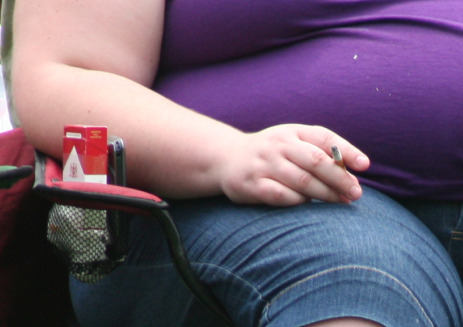 Photo courtesy Tobyotter via FlickrObesity and smoking prevention campaigns are increasingly fighting over funding. The New York Times documents the drop in money from foundations, federal sources, and statehouses. According to one report, state-funded anti-smoking programs decreased from $717 million two years ago, to $567 million last year.
Photo courtesy Tobyotter via FlickrObesity and smoking prevention campaigns are increasingly fighting over funding. The New York Times documents the drop in money from foundations, federal sources, and statehouses. According to one report, state-funded anti-smoking programs decreased from $717 million two years ago, to $567 million last year.
Well-known nutritionist Marion Nestle, who has been tracking this issue for some time, responded on her blog that “Health should not be a zero-sum game,” and recommended cooperation between advocates of the two issues.
Much money is still being spent on smoking prevention, clearly, and anti-smoking laws and cigarette taxes keep the “price” of smoking high. Yet the national smoking rate appears to be stuck at 20 percent.
But pulling back on obesity prevention, and/or demanding funding equity for these two public health issues may not be the best course.
Political scientist (and, full disclosure, an old friend of mine) James Fowler of the University of California, San Diego has some interesting thoughts about all this. He and his Harvard Medical School collaborator, Dr. Nicholas Christakis, have published studies of both smoking [PDF] and obesity [PDF] from the perspective of social networks, i.e. how smokers’ and the obese’s social relationships interact. It was out of this work that the two researchers developed the startling and newsmaking theory that obesity is “contagious.”
The basis for their research is the Framingham Heart study, a data set that tracked a large group of individuals’ relationships and habits for more than 30 years. Fowler and Christakis found that people stopped smoking in groups, and then pushed smokers out to the edge of their networks.
As a result, smokers tend to cluster; i.e. they stop hanging out with non-smokers. This means that the social pressure on smokers dissipates — and they can use their solidarity to withstand the outside pressure that does exist. As Fowler described the effect to NPR, using the metaphor of people at a party: “[B]y the end of the party, by the end of our 32-year study, the people in the center of the room are not smoking. And the people who continue to smoke have been literally pushed to the outside of the party, so that they’re in places where they’re only connected to one or two other people.”
In an email exchange, Fowler immediately shed doubt on the general consensus that the smoking rate is still at 20 percent — the Framingham data suggests it is much lower. And, he says, that while the true long-term costs and effects of smoking may be greater than for obesity, the fact is that current prevention programs may not be effective. “Our research showed that networks polarized between smokers and non-smokers starting in the mid-1980s (partly due to public health campaigns, probably), and that means it’s harder to reach smokers for interventions these days,” he wrote. “Even if you get them to stop, their friends all smoke, and there’s a good chance they will relapse.”
But obese people don’t self-segregate in quite the same way, according to the study. In other words, while having an obese friend may increase the likelihood you become obese (which is what Fowler and Christakis found), you still maintain friendships with non-obese friends. So, when obese people decide to lose weight, as Fowler puts it, “they are likely to have at least some people in their social circle they can turn to for support for the improvement.” This means that peer pressure — and social interventions — can still be effective for obesity, unlike for smoking.
So, reducing spending on preventing smoking in favor of upping it for obesity may be justified in terms of the payoff in changing unhealthy behavior. But when it comes to smoking, Fowler and Christakis’ results also suggest that continuing on as we have been may just be, well … blowing smoke.
Just for fun, here’s Fowler on the Colbert Report in January discussing the hidden power of social networks:



